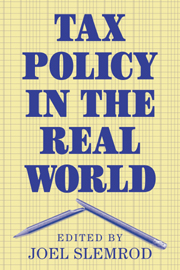Book contents
- Frontmatter
- Contents
- List of contributors
- 1 The real world of tax policy
- 2 Federal tax reform
- The corporate income tax: economic issues and policy options
- Changing views of the corporate income tax
- The American retail sales tax: considerations on their structure, operations, and potential as a foundation for a federal sales tax
- Would tax evasion and tax avoidance undermine a national retail sales tax?
- Life under a personal consumption tax: some thoughts on working, saving and consuming in Nunn-Domenici's tax world
- Living with the flat tax
- The international implications of consumption tax proposals
- 3 Federalism and subfederal taxes
- 4 Principles, politics, and the professors
- Index
The American retail sales tax: considerations on their structure, operations, and potential as a foundation for a federal sales tax
Published online by Cambridge University Press: 01 June 2010
- Frontmatter
- Contents
- List of contributors
- 1 The real world of tax policy
- 2 Federal tax reform
- The corporate income tax: economic issues and policy options
- Changing views of the corporate income tax
- The American retail sales tax: considerations on their structure, operations, and potential as a foundation for a federal sales tax
- Would tax evasion and tax avoidance undermine a national retail sales tax?
- Life under a personal consumption tax: some thoughts on working, saving and consuming in Nunn-Domenici's tax world
- Living with the flat tax
- The international implications of consumption tax proposals
- 3 Federalism and subfederal taxes
- 4 Principles, politics, and the professors
- Index
Summary
Abstract - Americans are familiar with the retail sales tax. Therefore, it is not surprising that Congress would consider such a tax as a way to tax consumption expenditure, should it choose to shift from the present federal structure that emphasizes income taxation. While the sales taxes are impressive revenue producers for state and local government, the taxes are poorly designed as consumption taxes: they tax too few household services, they exempt too many household purchases of goods, and they tax too many business inputs, especially capital asset purchases. State and local sales tax rates are relatively low, so compliance appears not to be a major problem, and economic distortions, while real, have not been a great difficulty. The much higher rates needed to replace the federal income tax would create many more problems. Most national governments choose the credit-invoice value-added tax if they seek substantial revenue from an indirect consumption tax. That is almost certainly a better option than the retail sales tax for a national indirect consumption tax in the United States as well.
INTRODUCTION
Retail sales taxes have been an American fiscal success. The tax that Mississippi initiated in 1932 by converting its fractional rate general business tax into a two percent tax on retail sales gave the state a tax that produced considerable revenue at low statutory rates and could be easily collected in relatively painless amounts on each transaction.
- Type
- Chapter
- Information
- Tax Policy in the Real World , pp. 43 - 60Publisher: Cambridge University PressPrint publication year: 1999
- 2
- Cited by



